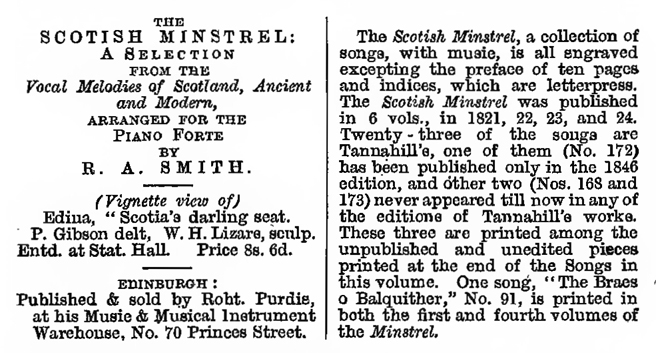Air—"Saw ye my wee thing".
1806.
Set to Music by Mr. John Ross, Aberdeen.
KEEN blaws the win o'er the braes o Gleniffer,
The auld castle's turrets are covered wi snaw ;
How changed frae the time when I met wi my lover
Amang the brume bushes by Stanely green shaw ;
The wild flowers o Simmer were spread a sae bonnie,
The mavis sang sweet frae the green birken tree ;
But far to the camp they hae march'd my dear Johnnie,
And now it is winter wi nature and me.
Then ilk thing aroun us was blythesome and cheery,
Then ilk thing aroun us was bonnie and braw ;
Now naething is heard but the win whistlin dreary,
And naething is seen but the wide spreadin snaw.
The trees are a bare, and the birds mute and dowie ;
They shake the cauld drift frae their wings as they flee,
And chirp out their plaints, seeming was for my Johnnie ;
Tis winter wi them and tis winter wi me.
Yon caul sleety cloud skiffs alang the bleak mountain,
And shakes the dark firs on the stey rocky brae,
While doun the deep glen bawls the snaw flooded fountain,
That murmur'd sae sweet to my laddie an me.
Tis no its loud roar, on the wintry win swellin,
Tis no the caul blast brings the tear to my ee,
For, oh, gin I saw my bonnie Scots callan,
The dark days o winter war simmer to me !
R. A. Smith, in one of his letters to the Editor of the Harp of Renfrewshire, page xxxviii., said—"Songs possessing great poetical beauty do not always become great favourites with the public.—‘Keen blaws the wind o'er the braes o' Gleniffer’ is perhaps Tannahill's best lyrical effusion, yet it does not appear to be much known ; at least, it is but seldom sung. It was written for the old Scottish melody, ‘Bonnie Dundee,’ but Burns had occupied the same ground before him. Mr. Ross of Aberdeen composed a very pretty air for it, yet, to use the phrase of a certain favourite vocal performer, it did not hit. The language and imagery of this song appear to me beautiful and natural. There is an elegant simplicity in the couplet,—
‘The wild flowers o Simmer were spread a sae bonnie,
The mavis sang sweet frae the green birken tree ;’
And the dreary appearance of the scenery in winter is strikingly portrayed in the second stanza,—
Now naething is heard but the win whistling dreary ;
And naething is seen but the wide spreading snaw.
Again—
The trees are a bare, and the birds mute and dowie ;
They shake the cauld drift frae their wings as they flee,
And chirp out their plaints, seeming was for my Johnnie ;
Tis winter wi them, and tis winter wi me.’
The birds shaking ‘the cauld drift frae their wings’ is an idea not unworthy of Burns. One of Tannahill's most favourite walks was by the ruins of Stanely Castle or over the Braes of Gleniffer. There he could recline on the brown heather, or sit on the side of a breckan-fringed rock, listen to the burn murmuring through the glen, and view the wild and varied scenery around him with a Poet's eye."
The Braes of Gleniffer was one of the favourite haunts of Tannahill. This mountainous range, lying east and west, is the boundary between Paisley and Neilston parishes. The forest of Passeleth was situated here. It was originally divided into three large portions, called Stanely, Thornly, and Fereneze. The north side of the ridge was afterwards called Paisley Braes, but now better known by the classic name of the Braes of Gleniffer. The south side of the ridge is called the Fereneze Braes. The lands of Stanely, part of the ridge of Paisley Braes, were granted by King Robert III. to Sir Robert Danyelston in 1392. One of his two daughters and co-heiresses married Sir Robert Maxwell, laird of Calderwood, in the parish of East Kilbride, and these lands, along with others, were allocated to Lady Calderwood. In the middle of the 15th century, the Maxwell family built on the lands a strong baronial residence, a massive piece of masonry, 40 feet high, which became well known by the name of Stanely Castle. The Maxwells continued in possession of the estate for several generations, and John Maxwell, in 1629, with consent of his son John, sold the estate to Jean Hamilton, dowager of Robert, fourth Lord Ross. It has continued in the Ross-Boyle families till the present time. The roof was taken off in 1714, when the “auld castle's turrets” and the inside of the building were exposed to the inclemency of the weather.
Stanely Castle, so hoary and grey, is now surrounded with a fine sheet of water,—the Reservoir of the Paisley Water Works,—covering an area of 50 acres of ground, and containing 34 millions of cubic feet of water “so placid, so calm, and so serene!”The supplying of the town of Paisley with water was projected by the late James Kerr, M.D., Paisley, and the works were inaugurated and opened on Friday, 13th July, 1838. Dr. Kerr died on 4th March, 1843, aged 79.
This song was printed in Smith's Scotish Minstrel in 1822, Vol. 11., page 7, to the Air, “Bonnie Dundee”.

Smith only uses one t in making his compound word of Scotish. He seems to be correct. The syllable Scot is the prefix, and the syllable ish is the of making Scot-ish, Scotish. The common way, however, in writing the word is Scottish the prefix being Scot, and the affix tish—Scot-tish, Scottish. Double consonants are not used in writing the words English, British, and Irish, as Engllish, Brittish, and Irrish.
[Semple 69]